Homemade Sauerkraut is a simple and healthy food that you can add to your diet. It’s salty and sour with a whole lot of flavor and probiotics. It is a very simple recipe that only needs two ingredients: cabbage and salt. Then just add a some time and you have a healthy and delicious side dish.
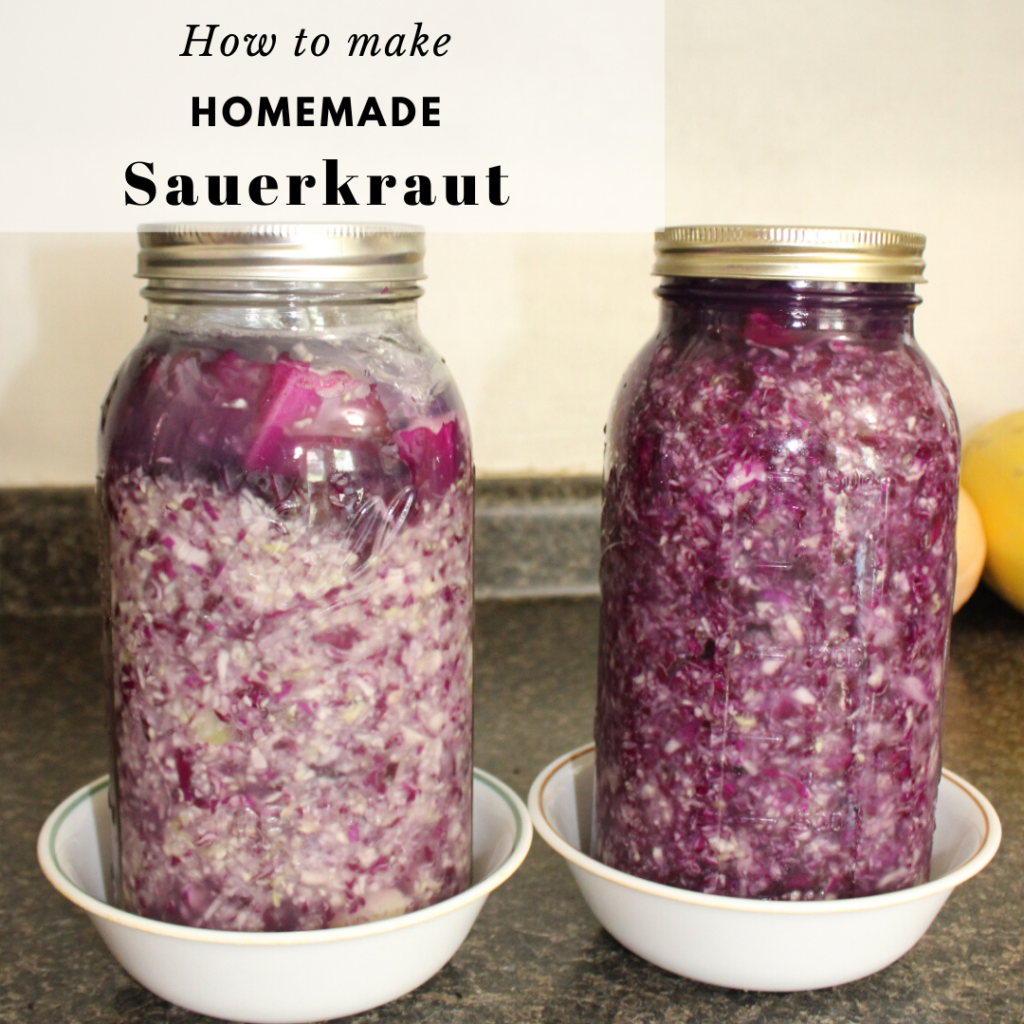
What is Sauerkraut?
Sauerkraut is a fermented food, chocked full of probiotics. It is finely cut raw cabbage that is mixed with salt and allowed to ferment for a period of time from a process called Lactic Acid Fermentation. From this process it creates acid from bacteria, eating the sugar in the cabbage. This process creates a very distinctive sour flavor and a long shelf life from the acid that is formed.
Sauerkraut is fermented for days or weeks, depending on your level of sour preference. Other similar fermented foods are things like Kimchi and Milk Kefir. Sauerkraut is a Chinese invention from about 2,000 years ago but was most commonly used in Central and Eastern Europe. They fermented food a lot back then as a way to preserve their food. The name was borrowed from the German language Sauer (sour), kraut (cabbage).
Health Benefits of Homemade Sauerkraut
Fermented Sauerkraut is very nutritious containing a large portion of essential vitamins and minerals.
Like other fermented foods, like yogurt, it has a lot of healthy bacteria. All of this bacteria will boost your good gut flora improving your digestion. So with regular consumption it can help regulate the good versus the bad bacteria in your digestive tract.
It boosts your immune system. Your gut health plays a big part in keeping a healthy immune system. The healthy bacteria present in sauerkraut helps keep the gut lining strong and healthy therefor helping to keep bad bacteria at bay, which would otherwise cause an immune response.
Sauerkraut has Vitamin K2, this may also help your heart health by reducing your cholesterol levels and it may even help keep your bones strong.
So instead of spending $30 or more a month on probiotics at your local health store, why not make your own. It is far less expensive, costing just a couple heads of cabbage and a few tablespoons of salt.
With making your own and having it with a meal, taking your probiotics is no longer a chore and you get to keep that extra money.
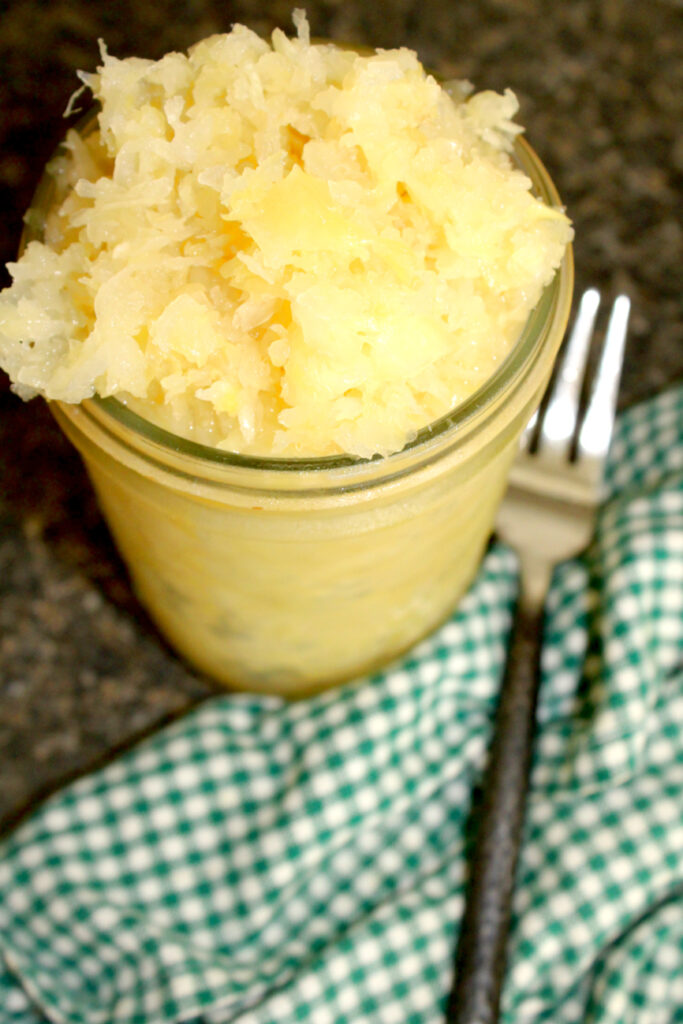
What goes good with Homemade Sauerkraut?
I personally tend to eat sauerkraut in the morning with my breakfast which usually consists of eggs. Be it a scrambled or an over-easy egg or even a crustless quiche. I even add it on my dinner plate with some chicken or steak with a side of mixed veggies and some acorn or butternut squash. Sometimes I eat it as is, by itself.
Another good meal it would taste good with is spaghetti squash “pasta” and hamburg with spaghetti sauce. You can put it as a side or mix it in. Honestly, it tastes good with just about anything. You could even put it as a topping on your pizza or wrap it in your burrito or calzone! The possibilities are endless.
Tips for Making Homemade Sauerkraut
- Shred your cabbage in your food processor with the shredder/food grater attachment. This makes smaller pieces which I feel allows it to ferment better and I prefer the texture of small pieces then larger chunks.
- If this is your first time making sauerkraut and don’t want to spend any extra money, find some small rocks and give them a really good cleaning. Then place them into a ziplock bag or two, seal them and use those as your weights.
- If your new to sauerkraut, try fermenting your cabbage for 3 days and give it a taste. 3-5 days is a pretty good range of keeping it from getting too sour. 5 days was perfect for the first time I made it.
- Place your fermentation jar in a shallow container while fermenting. The cabbage may continue to sweat, or create a brine and will leak out of the jar and make cleanup easier.
- If you are fermenting other things in your kitchen, try to keep your ferments about 4-5 feet away from each other. This is to prevent your different ferments from contaminating each other with their cultures. For example: your sourdough starter or your kombucha may pass on their cultures to your sauerkraut and vice versa, making it taste funny.
Tools you may need
Food processor
Half gallon mason jars
Measuring spoon
Fermentation weights or very clean rocks in ziplock bags
Fermentation lid or the lid that came with your jar
Ingredients
3 small heads of cabbage or 1 large and 1 small – green or purple
Sea salt – 1 tablespoon for every 1 3/4 pounds of cabbage
How to make Homemade Sauerkraut
Step 1: Shred the Cabbage
Remove the outer leaves of your cabbage that may not be very appealing, rinse them off and set aside for later use.
If your using a food processor, cut up your cabbage into chunks that can fit through the tube on the lid. If cutting the cabbage by hand, cut it as small as possible, about coleslaw consistency.
Note: Don’t forget to cut out the core – it is very tough and not that tasty.
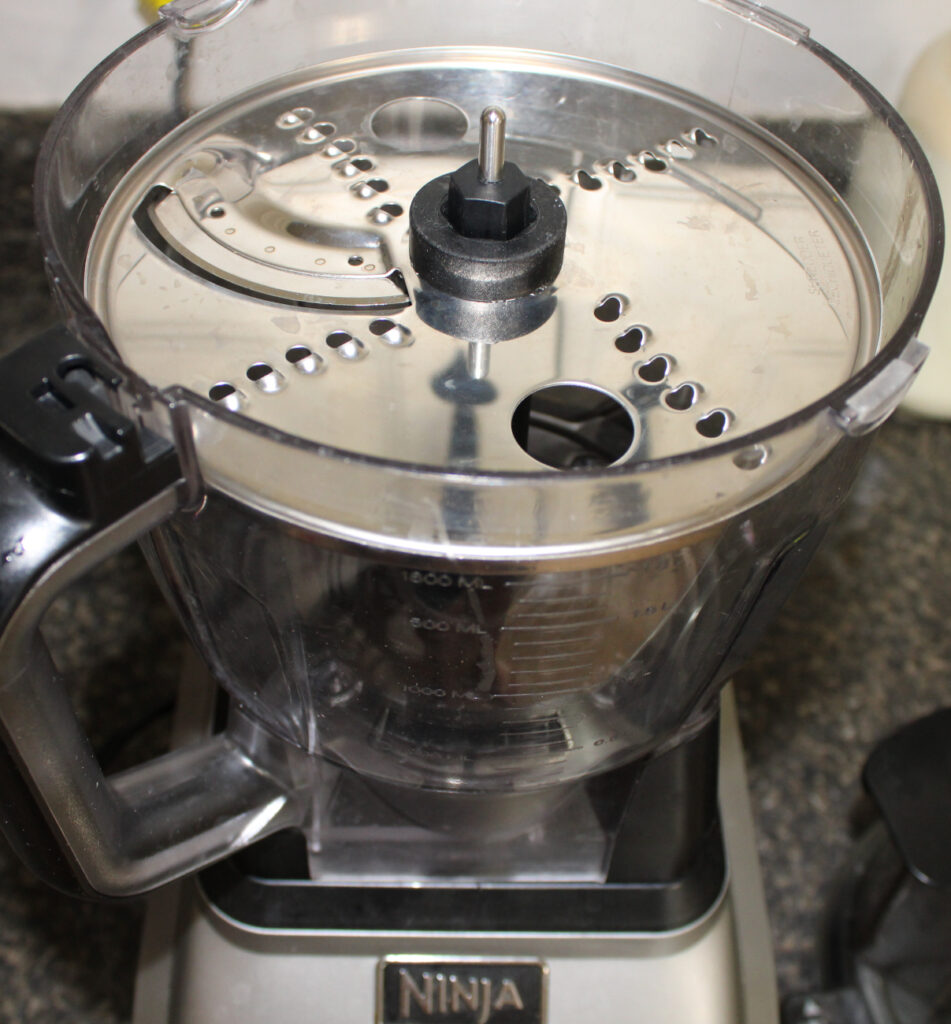
Once you have cut all your cabbage into small chunks go ahead and run it though the processor with the shredder/grater attachment.
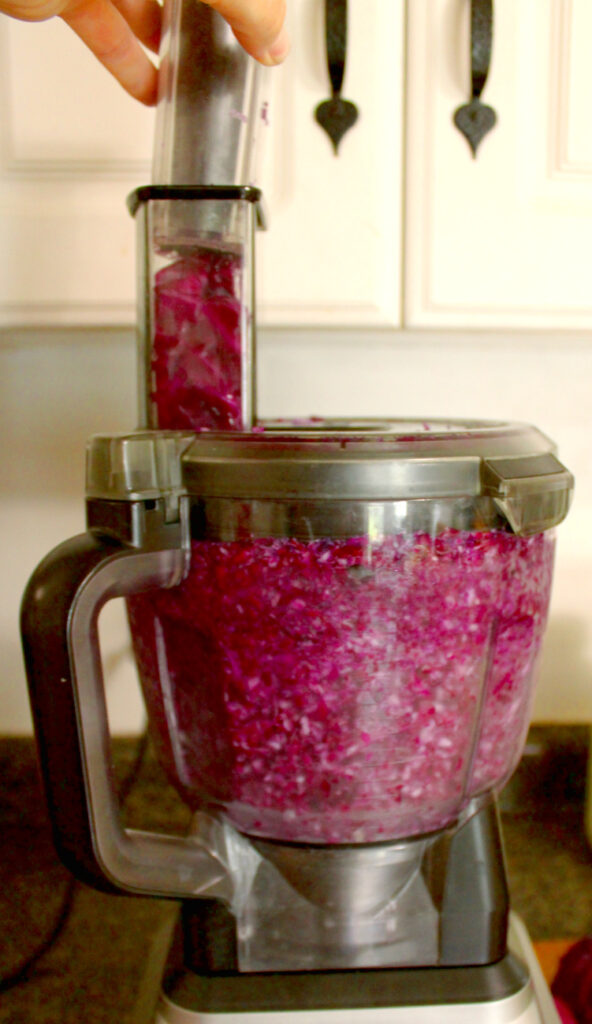
Step 2: Mix in the salt
Once all the cabbage is shredded, add it to a large bowl and sprinkle on the required amount of salt for how much cabbage you have (1 tbs sea salt per 1 3/4 pounds of cabbage).
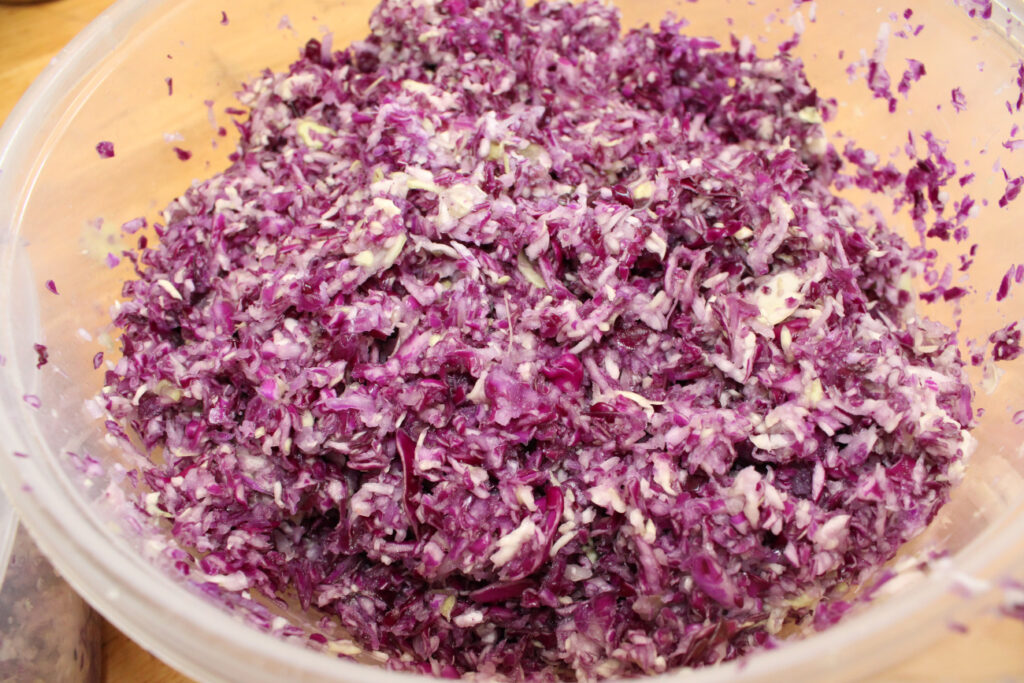
Mix the salt into the cabbage very well. You will notice that a brine is starting to form as you mix it in. This is the liquid you want your cabbage to sit below of in your jar. This will keep the air from reaching the cabbage, preventing it from going bad and molding. You may need to mix it in for a few minutes until you have enough.
Step 3: Pack it away
Add the cabbage and brine to your jar and pack it down well. With the cabbage leaves you set aside earlier, place them on top of your cabbage, just below the neck of the jar. Try to keep all the shredded cabbage and the whole leaves below the brine.
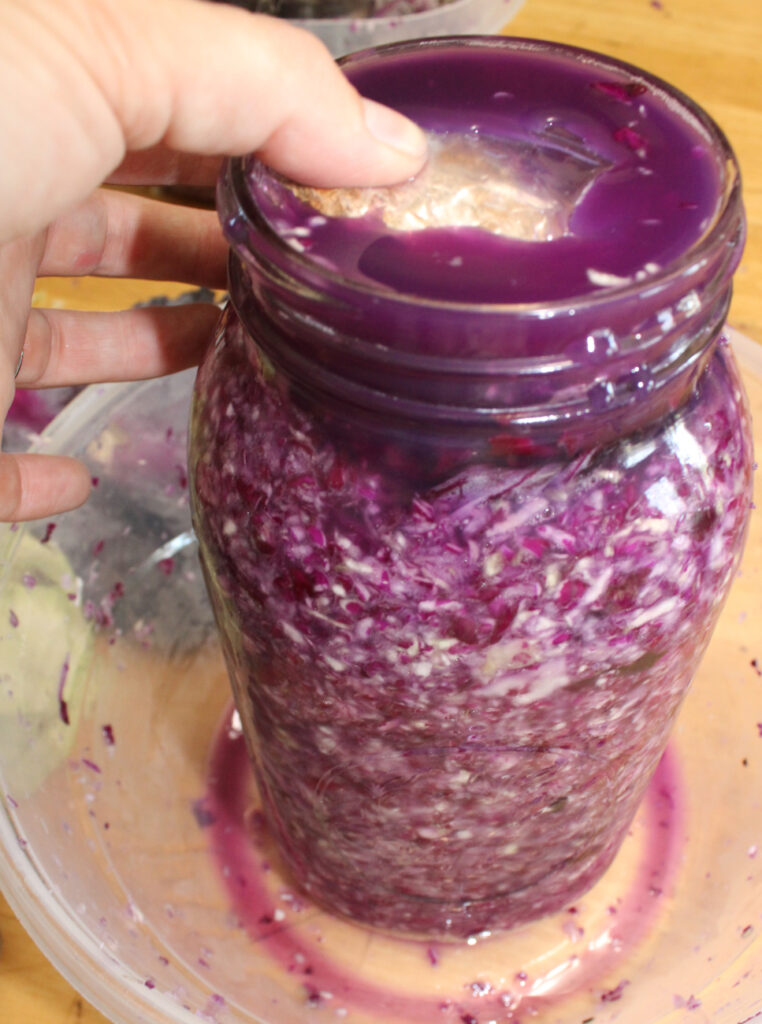
Add the rocks in the sealed ziplock bag or your fermentation weights to the jar. If your able to, try to get them below the brine as well. If there isn’t quite enough brine to cover all of the cabbage leaves on top, add some filtered water to make up the difference.
LOOSELY place your jar lid on or use your fermentation lid. Place it on your counter and let it ferment for 3 -10 days.
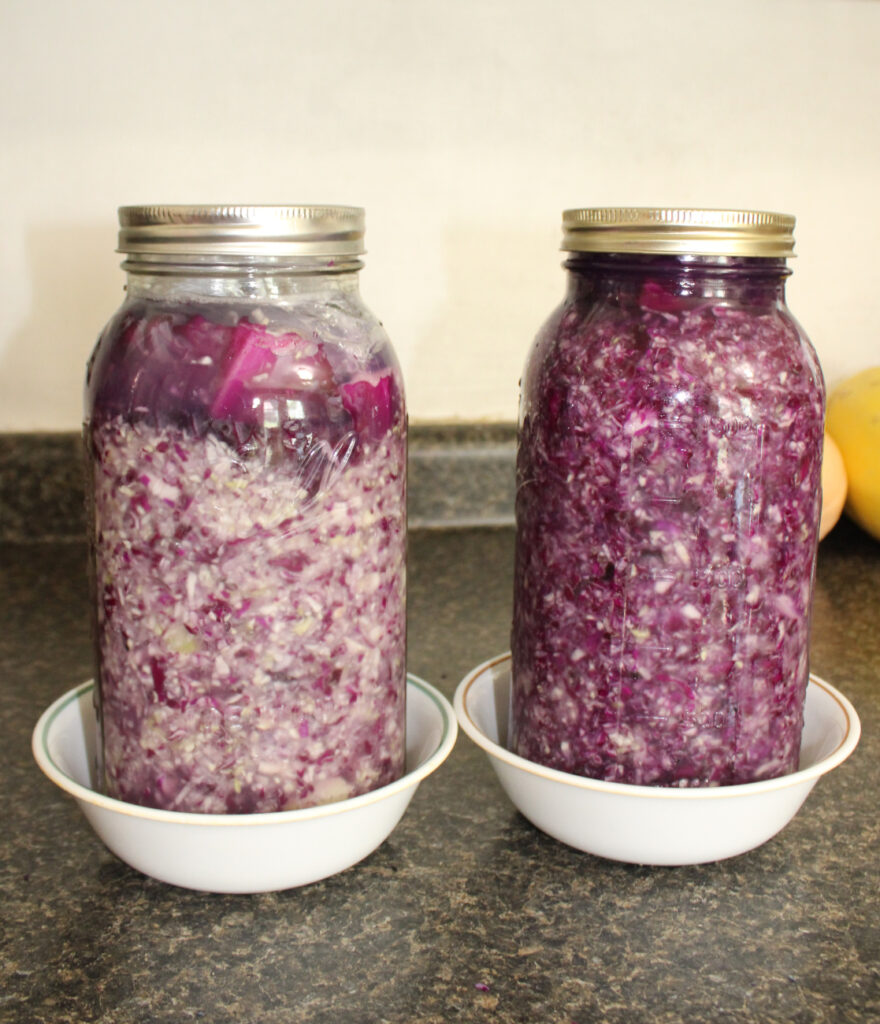
Once your sauerkraut has reached your level of sourness, pop it in the fridge to stop the fermentation.
Now, just serve it up with your favorite meal.
Voila! You’ve made your own probiotics!
Variations of Homemade Sauerkraut
Make it with purple cabbage for added color and a bit of a peppery flavor. Purple cabbage is also known to have more beneficial properties then green cabbage.
You could try adding fruit, some people will shred apples and mix that in with the cabbage. You can also add things like carrots, radishes or beets.
If you are interested in other fermented food, Kombucha is a sweet and tasty fermented tea. Read about it and learn how to make it HERE
Homemade Sauerkraut Recipe
Show your support and appreciation. If you made this recipe and loved it, give it a 5 star review and leave a comment. Follow me on Instagram @naturalliving.homestead then tag me in a photo of your amazing creation! Thank you!
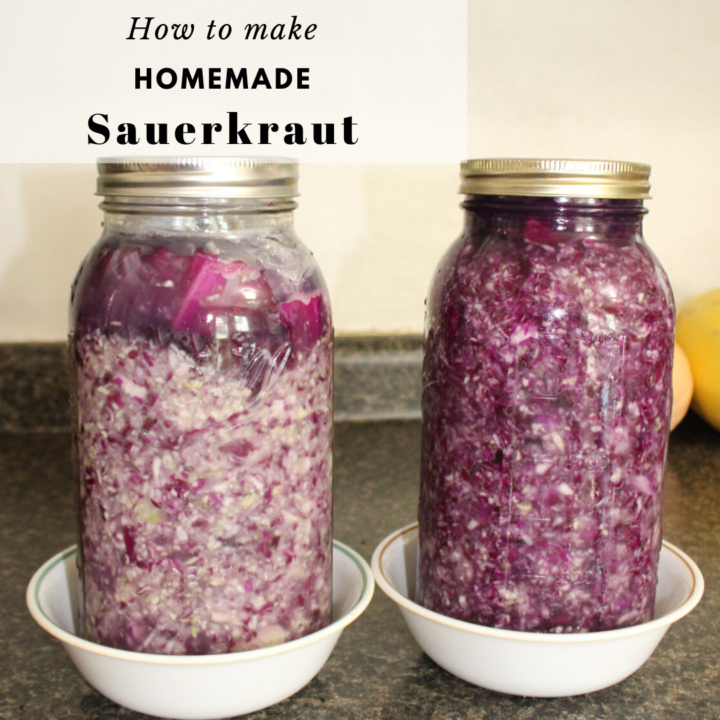
Homemade Sauerkraut
Make a probiotic rich side dish thats salty and sour. Add it as a side or put it as a topping on your pizza. It's an easy way to take your probiotics every day.
Ingredients
- 3 small heads of cabbage or 1 large and 1 small - green or purple
- Sea salt - 1 tablespoon for every 1 3/4 pounds of cabbage
Instructions
Step 1: Shred the Cabbage
Remove the outer leaves of your cabbage that may not be very appealing, rinse them off and set aside for later use.
If your using a food processor, cut up your cabbage into chunks that can fit through the tube on the lid. If cutting the cabbage by hand, cut it as small as possible, about coleslaw consistency.
Note: Don't forget to cut out the core - it is very tough and not that tasty.
Once you have cut all your cabbage into small chunks go ahead and run it though the processor with the shredder/grater attachment.
Step 2: Mix in the salt
Once all the cabbage is shredded, add it to a large bowl and sprinkle on the required amount of salt for how much cabbage you have (1 tbs sea salt per 1 3/4 pounds of cabbage).
Mix the salt into the cabbage very well. You will notice that a brine is starting to form as you mix it in. This is the liquid you want your cabbage to sit below of in your jar. This will keep the air from reaching the cabbage, preventing it from going bad and molding. You may need to mix it in for a few minutes until you have enough.
Step 3: Pack it away
Add the cabbage and brine to your jar and pack it down well. With the cabbage leaves you set aside earlier, place them on top of your cabbage, just below the neck of the jar. Try to keep all the shredded cabbage and the whole leaves below the brine.
Add the rocks in the sealed ziplock bag or your fermentation weights to the jar. If your able to, try to get them below the brine as well. If there isn't quite enough brine to cover all of the cabbage leaves on top, add some filtered water to make up the difference.
LOOSELY place your jar lid on or use your fermentation lid. Place it on your counter and let it ferment for 3 -10 days.
Once your sauerkraut has reached your level of sourness, pop it in the fridge to stop the fermentation.
Now, just serve it up with your favorite meal.
Voila! You've made your own probiotics!
Notes
- Shred your cabbage in your food processor with the shredder/food grater attachment. This makes smaller pieces which I feel allows it to ferment better and I prefer the texture of small pieces then larger chunks.
- If this is your first time making sauerkraut and don't want to spend any extra money, find some small rocks and give them a really good cleaning. Then place them into a ziplock bag or two, seal them and use those as your weights.
- If your new to sauerkraut, try fermenting your cabbage for 3 days and give it a taste. 3-5 days is a pretty good range of keeping it from getting too sour. 5 days was perfect for the first time I made it.
- Place your fermentation jar in a shallow container while fermenting. The cabbage may continue to sweat, or create a brine and will leak out of the jar and make cleanup easier.
- If you are fermenting other things in your kitchen, try to keep your ferments about 4-5 feet away from each other. This is to prevent your different ferments from contaminating each other with their cultures. For example: your sourdough starter or your kombucha may pass on their cultures to your sauerkraut and vice versa, making it taste funny.
PIN IT FOR LATER


Thank you for this easy to follow guide! I’m looking forward to trying fermenting for my first time!
Your welcome! I hope you have fun!
Yes, homemade sauerkraut is SO much cheaper than buying it, even if it’s slightly more time consuming. I love the color of the purple one, I’ve only ever done green cabbage!
The purple tastes just as good as the green! The color is beautiful!